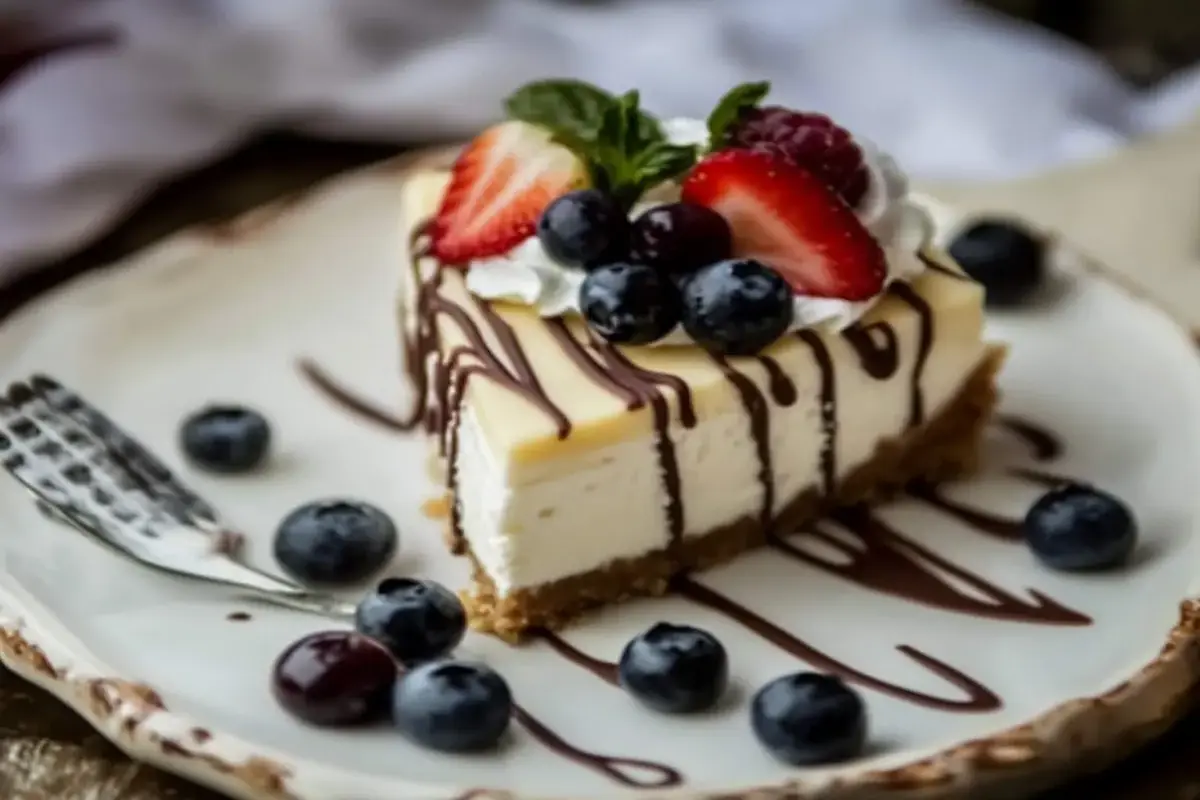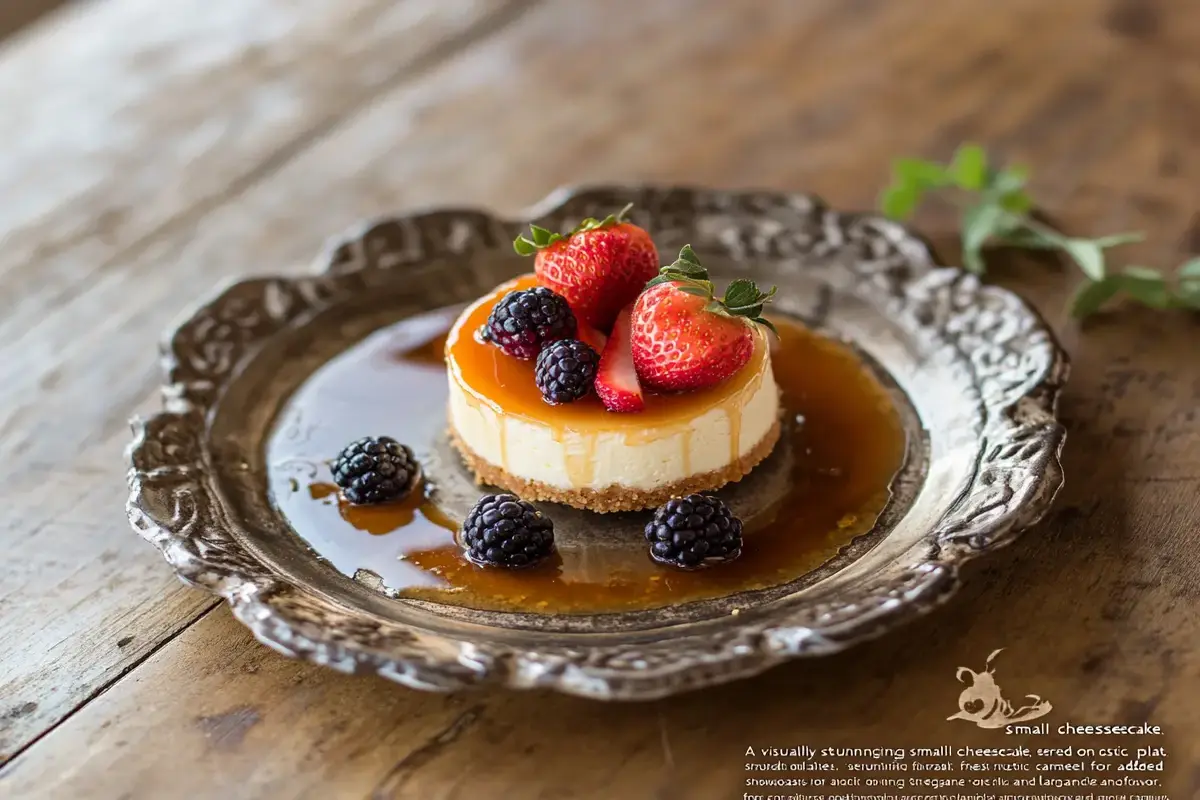Introduction
Cheesecake is one of those timeless desserts that feels fancy yet comforting. But what if you don’t need a full-sized cake? Enter the small cheesecake recipe! Whether you’re cooking for two, planning a party, or just craving a personal treat, small cheesecakes are the perfect solution. They’re versatile, easy to customize, and don’t require the commitment of a large cheesecake.
In this guide, we’ll explore everything from the benefits of small cheesecakes to step-by-step instructions, popular variations, and tips to ensure your cheesecakes turn out flawless every time. Let’s dive into the world of these delightful, bite-sized treats!
Why Choose Small Cheesecake Recipes?
Advantages of Small Cheesecake Recipes
There’s no denying the convenience and charm of a small cheesecake recipe. First, they’re perfect for portion control. A small cheesecake gives you just enough to satisfy your craving without having leftovers staring at you from the fridge all week. This makes them ideal for individuals or small families.
Small cheesecakes are also quicker to make. Since they’re smaller, they bake and cool faster, meaning less waiting and more eating. Plus, they’re a lot more versatile—you can make several variations in one batch by tweaking toppings or fillings, making them a hit for parties or gatherings.
Another perk? They’re easy to store and transport. Pack them in airtight containers for picnics or work lunches, and you’ve got a fancy dessert ready to go.
When to Opt for Small Cheesecakes Over Regular Ones
Small cheesecakes shine in specific scenarios. For date nights, they’re a romantic and hassle-free dessert. For parties, their individual servings add a touch of elegance without the mess of slicing and serving. They’re also great for experimenting. Want to try a new flavor or technique? A small cheesecake recipe is a low-risk way to test your creativity without committing to a full cake.
Whether for portion control, convenience, or variety, small cheesecakes prove that good things really do come in small packages.
Essential Ingredients for Small Cheesecake Recipes
Key Ingredients for the Cheesecake Base
The secret to a perfect small cheesecake recipe lies in the quality of the ingredients. Start with cream cheese as the primary base—opt for full-fat cream cheese for a rich and creamy texture. Granulated sugar is necessary to balance the tanginess of the cheese. For flavor, vanilla extract is a must, while a dash of salt enhances the overall taste.
Eggs are crucial for binding the mixture and creating a smooth consistency. For a lighter texture, add sour cream or heavy cream. These ingredients ensure the cheesecake is velvety and indulgent in every bite.
Choosing the Right Crust for Small Cheesecakes
The crust is the foundation of any cheesecake. Graham crackers are the most popular choice, but you can also experiment with crushed cookies, such as Oreos or digestive biscuits, for a unique twist. Combine your chosen crumbs with melted butter and a touch of sugar, then press the mixture firmly into your molds or springform pan.
For small cheesecakes, individual crusts can be prepared in muffin tins with liners or mini tart pans. Pre-baking the crust for 5–8 minutes at 350°F ensures it holds its shape and adds a delightful crunch.
Optional Add-Ins for Unique Flavors
Adding creative ingredients to your small cheesecake recipe can elevate it to the next level. Mix in a swirl of fruit puree, like strawberry or raspberry, for a fruity twist. Chocolate chips, caramel drizzle, or a hint of citrus zest can also add depth and character.
If you’re looking for more dessert inspiration, check out unique dessert recipes on Gustoff Recipes.
Step-by-Step Guide to Making Small Cheesecakes
Preparing the Cheesecake Crust
To start your small cheesecake recipe, begin by preparing the crust. Combine 1 cup of graham cracker crumbs, 2 tablespoons of sugar, and 4 tablespoons of melted butter. Stir until the mixture resembles wet sand. Scoop a small amount into muffin liners or mini tart pans, pressing firmly with the back of a spoon.
Preheat your oven to 350°F and bake the crusts for 5–8 minutes. This step creates a solid base and enhances the flavor of the crust.
Mixing and Perfecting the Filling
For the filling, beat softened cream cheese and sugar until smooth. Add eggs one at a time, mixing on low speed to avoid air bubbles. Stir in vanilla extract and sour cream for a creamy texture. If desired, fold in additional flavors, like fruit puree or chocolate chips.
Pour the filling into the pre-baked crusts, filling each mold about 3/4 full. This ensures even cooking and leaves room for toppings.
Baking Small Cheesecakes to Perfection
Place the filled molds on a baking sheet and bake at 325°F for 18–22 minutes, or until the centers are slightly jiggly. Avoid overbaking, as it can lead to cracks. Once baked, let the cheesecakes cool at room temperature before transferring them to the refrigerator for at least 2–3 hours to set.
How to Make No-Bake Small Cheesecakes
For a no-bake option, skip the eggs and baking process. Use gelatin or whipped cream as a stabilizer. After preparing the crust, chill it in the fridge. Combine the cream cheese mixture and pour it into the molds. Refrigerate for 4–6 hours or until firm.
Popular Variations of Small Cheesecake Recipes
Classic Small Cheesecakes with a Graham Cracker Crust
A small cheesecake recipe with a graham cracker crust is a timeless choice. The buttery, slightly sweet crust perfectly complements the creamy filling. For a classic twist, you can top these mini cheesecakes with a dollop of whipped cream and a fresh fruit garnish, like a strawberry or blueberry.
To create this variation, use standard ingredients like cream cheese, sugar, eggs, and vanilla. This simple recipe is ideal for parties, as the individual portions are both elegant and convenient.
Mini Chocolate Cheesecakes
For chocolate lovers, mini chocolate cheesecakes are a decadent treat. Start by adding melted chocolate to your cheesecake batter. A chocolate cookie crust, such as Oreos, enhances the richness and pairs beautifully with the filling.
After baking, top these mini cheesecakes with a layer of chocolate ganache and sprinkle them with shaved chocolate or cocoa powder. This variation is perfect for satisfying any sweet tooth.
Fruity Small Cheesecakes with Fresh Toppings
Fruit-topped small cheesecakes are light, refreshing, and visually stunning. Use fresh berries, mango slices, or kiwi as a topping. Alternatively, swirl fruit puree into the batter before baking to create a beautiful marbled effect.
This variation works well for summer events, as the fruit adds a natural sweetness and vibrant color. Serve chilled for the best flavor and presentation.
Seasonal Small Cheesecakes for Special Occasions
Make your small cheesecake recipe festive by incorporating seasonal flavors. For fall, add pumpkin puree and spices like cinnamon and nutmeg to the batter. During winter, try peppermint extract and crushed candy canes for a holiday-inspired treat.
Seasonal variations allow you to customize cheesecakes to match the time of year, making them a versatile dessert option for any occasion.
Troubleshooting Small Cheesecake Problems
How to Prevent Cracks in Small Cheesecakes
Cracks in cheesecakes are a common issue, but they’re easy to avoid with a few simple steps. First, bake your small cheesecake recipe at a low temperature to ensure even cooking. Overmixing the batter can also introduce air bubbles, which lead to cracks. Mix on low speed and stop as soon as the ingredients are combined.
Using a water bath is another effective way to prevent cracks. The steam created during baking helps maintain a consistent temperature, keeping the cheesecake surface smooth.

What Does Adding an Extra Egg to Cheesecake Do?
Adding an extra egg to your small cheesecake recipe can significantly impact the texture. More eggs create a denser and richer cheesecake, while fewer eggs result in a lighter and fluffier texture. Keep in mind that overusing eggs can make the batter too liquidy, potentially leading to cracks or an overly firm texture.
Experimenting with egg quantities allows you to customize the texture to your liking. For small cheesecakes, one egg is often sufficient for achieving a perfect balance between creaminess and structure.
For more helpful tips and creative dessert ideas, explore additional recipes on Gustoff Recipes.
Tips for Storing and Serving Small Cheesecakes
How to Store Small Cheesecakes Properly
Storing your small cheesecake recipe correctly is key to maintaining its freshness and flavor. Once the cheesecakes have cooled to room temperature, place them in an airtight container to prevent them from drying out. Store them in the refrigerator for up to five days. For longer storage, freezing is an excellent option.
To freeze, wrap each small cheesecake individually in plastic wrap, then place them in a resealable freezer bag. This method ensures they remain fresh for up to three months. When you’re ready to serve, thaw the cheesecakes in the refrigerator overnight for the best texture and taste.

Creative Ways to Serve Small Cheesecakes
Serving small cheesecakes is an opportunity to get creative. Top each cheesecake with fresh fruit, chocolate drizzle, or a swirl of caramel for added elegance. You can also pipe whipped cream on top and garnish with edible flowers or sprinkles for a festive touch.
For variety, set up a cheesecake topping bar with options like crushed cookies, chopped nuts, and syrups. This interactive serving style is perfect for parties, allowing guests to personalize their desserts. Whether served plain or adorned with toppings, a small cheesecake recipe always makes a delightful impression.
FAQs About Small Cheesecake Recipes
What Is the Difference Between New York Style Cheesecake and Regular Cheesecake?
New York-style cheesecake is denser and richer, thanks to the addition of heavy cream or sour cream, while regular cheesecake tends to be lighter and fluffier. A small cheesecake recipe can incorporate either style depending on your preference. If you love a tangy, creamy flavor, go for a New York-style version. For a more delicate texture, opt for the regular approach.
What Are the Three Types of Cheesecake?
Cheesecake comes in three main types: baked, no-bake, and New York-style. A baked small cheesecake recipe uses eggs for a firm yet creamy texture. No-bake versions rely on gelatin or whipped cream, making them lighter and quicker to prepare. New York-style cheesecakes are known for their dense and luxurious consistency, often achieved by baking at a low temperature.
What Is the Secret to Making Good Cheesecake?
The secret to a perfect cheesecake lies in attention to detail. Ensure all ingredients are at room temperature to achieve a smooth batter. Avoid overmixing to prevent air bubbles, which can lead to cracks. For a small cheesecake recipe, baking at a low and steady temperature ensures even cooking and a creamy texture.
What Does Adding an Extra Egg to Cheesecake Do?
Adding an extra egg to your small cheesecake recipe can make the texture denser and richer. However, too many eggs can result in an overly firm cheesecake. To achieve the perfect balance, follow the recipe’s egg-to-cream cheese ratio and adjust slightly based on your desired texture.
Common Challenges and Solutions for Small Cheesecakes
How to Avoid Overbaking Small Cheesecakes
Overbaking is a common issue when making a small cheesecake recipe. To prevent this, bake at a lower temperature, typically 325°F, and keep a close eye on the texture. The cheesecake is done when the edges are set, but the center still has a slight jiggle. Overbaking can cause cracks and a dry texture.
Using a water bath can help maintain a steady temperature and prevent overcooking. If you don’t have a water bath, placing a pan of water on the bottom oven rack can achieve similar results by adding moisture to the air.
How to Fix Cracked Cheesecake Tops
Cracks in your cheesecake can occur if the batter is overmixed or the oven temperature is too high. To avoid this, mix ingredients on low speed and stop as soon as they are combined. Additionally, cooling the cheesecake gradually by leaving it in the oven with the door slightly ajar helps prevent sudden temperature changes that cause cracking.
If cracks do appear, no need to worry! Simply cover them with a topping like whipped cream, fresh fruit, or chocolate ganache for a flawless presentation.
Exploring Different Cheesecake Styles
What Are the Three Types of Cheesecake?
If you’ve ever wondered, What are the three types of cheesecake?, the answer lies in their preparation methods. The three primary types are:
- Baked Cheesecake: This traditional method involves eggs and baking, creating a rich, creamy texture. Baked cheesecakes are often denser and more decadent.
- No-Bake Cheesecake: Perfect for quick and easy desserts, no-bake cheesecakes use gelatin or whipped cream to set the filling. They are lighter and ideal for warm weather.
- New York-Style Cheesecake: Known for its dense and velvety texture, New York-style cheesecake includes heavy cream or sour cream. It’s baked at a lower temperature for a luxurious consistency.
Each type offers its own unique qualities, making it easy to adapt your small cheesecake recipe to suit your preferences.
When to Choose Each Cheesecake Type
The choice between baked, no-bake, and New York-style cheesecake depends on the occasion and your taste. For formal gatherings, baked or New York-style cheesecakes provide a rich and indulgent dessert. If you’re short on time or prefer a lighter option, no-bake cheesecakes are the way to go.
By understanding what are the three types of cheesecake, you can experiment and create the perfect dessert for any situation.

